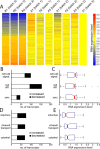Axonal mRNA in uninjured and regenerating cortical mammalian axons
- PMID: 19369540
- PMCID: PMC3632375
- DOI: 10.1523/JNEUROSCI.6130-08.2009
Axonal mRNA in uninjured and regenerating cortical mammalian axons
Abstract
Using a novel microfluidic chamber that allows the isolation of axons without contamination by nonaxonal material, we have for the first time purified mRNA from naive, matured CNS axons, and identified the presence of >300 mRNA transcripts. We demonstrate that the transcripts are axonal in nature, and that many of the transcripts present in uninjured CNS axons overlap with those previously identified in PNS injury-conditioned DRG axons. The axonal transcripts detected in matured cortical axons are enriched for protein translational machinery, transport, cytoskeletal components, and mitochondrial maintenance. We next investigated how the axonal mRNA pool changes after axotomy, revealing that numerous gene transcripts related to intracellular transport, mitochondria and the cytoskeleton show decreased localization 2 d after injury. In contrast, gene transcripts related to axonal targeting and synaptic function show increased localization in regenerating cortical axons, suggesting that there is an increased capacity for axonal outgrowth and targeting, and increased support for synapse formation and presynaptic function in regenerating CNS axons after injury. Our data demonstrate that CNS axons contain many mRNA species of diverse functions, and suggest that, like invertebrate and PNS axons, CNS axons synthesize proteins locally, maintaining a degree of autonomy from the cell body.
Figures





References
-
- Bassell GJ, Singer RH, Kosik KS. Association of poly(A) mRNA with microtubules in cultured neurons. Neuron. 1994;12:571–582. - PubMed
Publication types
MeSH terms
Substances
Grants and funding
LinkOut - more resources
Full Text Sources
Molecular Biology Databases
